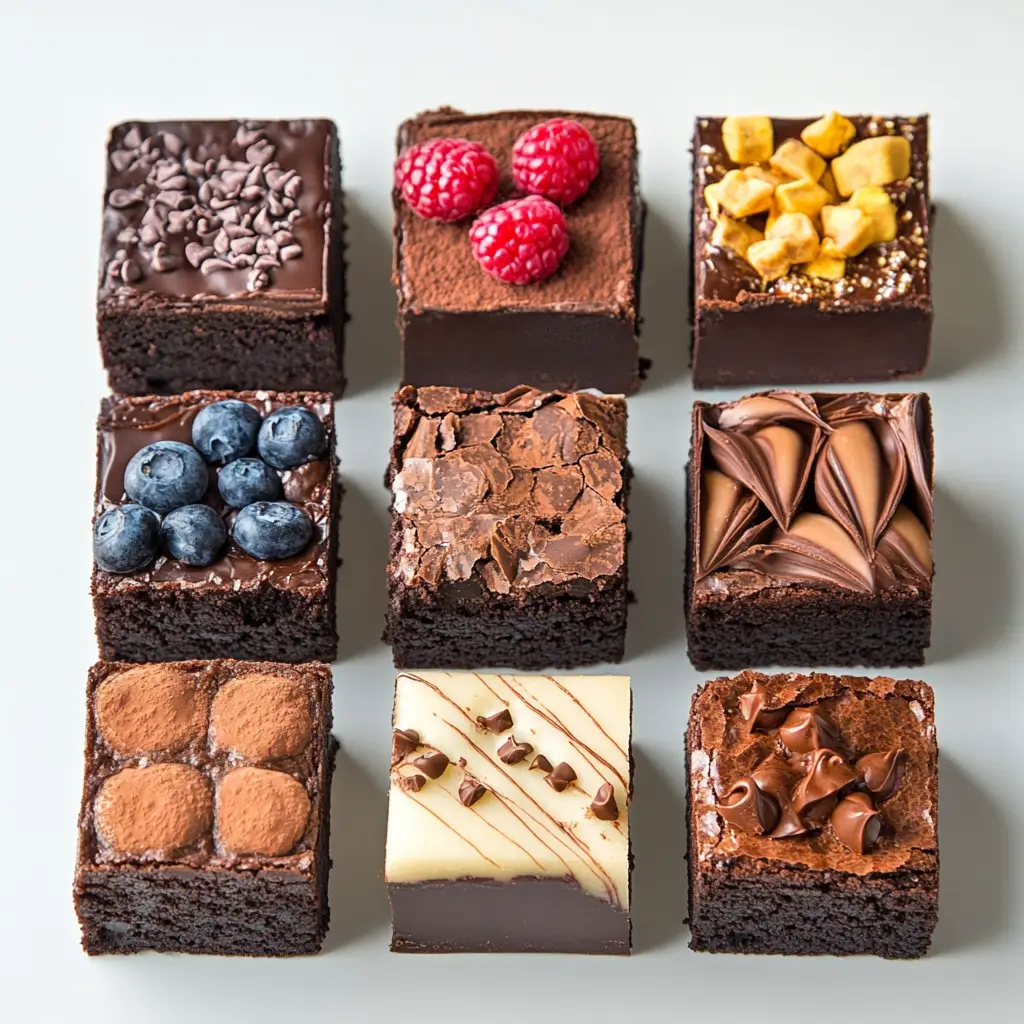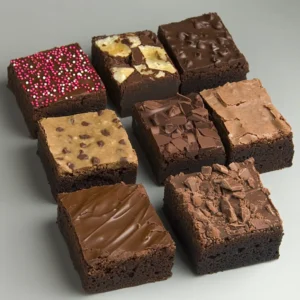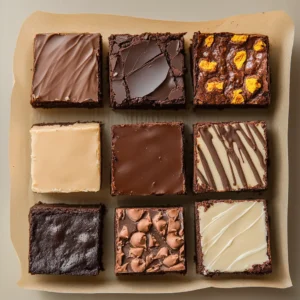Brownies are one of the most versatile and beloved desserts in the world. Whether you enjoy them rich and fudgy, light and cakey, or filled with unique flavors, brownies always manage to satisfy a sweet craving. But have you ever wondered: How many different types of brownies are there? In this comprehensive guide, we’ll explore the various types of brownies, from classic versions to creative international twists.
Introduction: The Irresistible World of Brownies
Brownies occupy a special place in the world of baked desserts. With a perfect mix of chocolatey richness, customizable textures, and endless flavor options, they’ve become a household favorite. What makes brownies truly fascinating is their adaptability—you can make them dense and fudgy, airy and cakey, or chewy with a delightful bite.
This guide takes you on a journey through the different types of brownies, their unique characteristics, and creative variations from around the globe. Whether you’re a baker looking for inspiration or a dessert lover curious about brownie diversity, you’ll find all the answers here.
A Brief History of Brownies
The origin of brownies dates back to the late 19th century in the United States. The first recorded brownie recipe appeared in the 1897 Sears, Roebuck catalog. It was described as a dense, cake-like chocolate treat. The accidental invention story often involves a baker forgetting to add baking powder to a chocolate cake batter, resulting in a dense and fudgy dessert.
Over time, brownies evolved into the treat we know today, with countless variations being developed across different cultures. Their simplicity—requiring only a few staple ingredients like flour, eggs, butter, and chocolate—allowed bakers to experiment freely.
Classic Brownies: The Foundation of All Variants
At their core, brownies are divided into three main categories based on texture: fudgy, cakey, and chewy. These classic brownies form the foundation for all other variations.
Fudgy Brownies
Fudgy brownies are dense, moist, and rich, with a smooth, melt-in-your-mouth texture. To achieve this indulgent consistency, the recipe uses minimal flour and a higher ratio of butter and chocolate. The key lies in limiting the flour, which keeps the brownies from becoming dry or cakey.
Incorporating melted chocolate instead of cocoa powder further enhances the richness and depth of flavor, contributing to the velvety texture. This method ensures a soft, almost gooey interior that defines the perfect fudgy brownie.
Cakey Brownies
Cakey brownies are lighter and airier, resembling chocolate cake but with a slightly denser structure. To achieve this texture, these brownies use more flour and often include baking powder or baking soda as a leavening agent. This helps the batter rise, creating a tender crumb and fluffy consistency. While still rich in flavor, cakey brownies have a drier and more structured texture compared to their fudgy counterparts.
Chewy Brownies
Traditional American Brownies
Traditional American brownies often combine elements of all three main textures—fudgy, cakey, and chewy. They are rich and intensely chocolate-forward, delivering a deep, satisfying cocoa flavor. To enhance their appeal, they may include nuts such as walnuts or pecans, which add a pleasant crunch and contrast to the smooth, dense texture of the brownies. This classic treat strikes a delicious balance, making it a beloved staple in American baking.
Special Dietary Brownies
As dietary preferences have evolved, so have brownies. Today, there are brownies tailored to fit various diets without compromising on flavor or texture. Options now include gluten-free brownies made with almond flour or oat flour, vegan brownies that replace eggs and butter with plant-based alternatives like flaxseed and coconut oil, and keto-friendly brownies that use low-carb sweeteners and almond flour. Additionally, brownies can be adapted for paleo diets using natural sweeteners like honey or maple syrup. These modern variations ensure that everyone, regardless of their dietary needs, can enjoy a delicious, satisfying brownie.
Gluten-Free Brownies
Gluten-free brownies use alternative flours such as almond flour, oat flour, or gluten-free all-purpose flour. These substitutes allow the brownies to maintain the richness and chocolate-forward flavor of traditional brownies while being suitable for individuals with gluten intolerance or celiac disease. The choice of flour can also add unique qualities—almond flour brings a subtle nuttiness, while oat flour provides a soft, tender texture. With the right balance of ingredients, gluten-free brownies remain just as indulgent and satisfying as their classic counterparts.
Vegan Brownies
Vegan brownies replace eggs and dairy with plant-based alternatives, making them suitable for a vegan diet. Common substitutes include flax eggs (a mixture of ground flaxseed and water), applesauce, mashed bananas, and coconut oil. These ingredients help bind the batter and provide moisture, ensuring the brownies maintain their fudgy texture and rich flavor. When balanced correctly, vegan brownies can be just as indulgent, moist, and chocolatey as traditional ones, proving that you don’t need animal products to enjoy a delicious brownie.
Keto and Low-Carb Brownies
For those following a ketogenic or low-carb diet, brownies can be made using almond flour or coconut flour as low-carb alternatives to traditional flour. Sugar substitutes like erythritol or monk fruit are used in place of regular sugar, keeping the carb count low while maintaining sweetness. Despite being tailored for a specific diet, these brownies remain rich, indulgent, and chocolatey, providing a satisfying treat without the excess carbs.
Sugar-Free Brownies
Sugar-free brownies cater to those avoiding sugar for health reasons, such as managing diabetes or reducing overall sugar intake. These brownies achieve their sweetness through natural sweeteners like dates or honey, or sugar alternatives such as stevia, erythritol, or monk fruit. These ingredients provide a delicious level of sweetness without causing a spike in blood sugar. With the right balance of flavors, sugar-free brownies can be just as rich, moist, and satisfying as traditional ones, offering a guilt-free indulgence for those seeking healthier options.
Brownies with a Twist: Creative Flavors
Classic brownies are delicious on their own, but bakers have introduced creative flavors to elevate this beloved dessert. Additions like caramel swirls, peanut butter, or cream cheese create decadent layers of flavor. Ingredients such as espresso or sea salt enhance the chocolate’s richness, while mix-ins like nuts, chocolate chips, or toffee bits provide added texture and variety. For a unique twist, flavors like mint, orange zest, or spices such as cinnamon and chili can transform traditional brownies into exciting and sophisticated treats. These innovations keep brownies timeless yet versatile, appealing to every palate.
Peanut Butter Brownies
Adding a swirl of creamy or chunky peanut butter creates a delightful contrast to the rich chocolate base of brownies. The nutty, salty flavor of peanut butter complements the sweetness of the brownies, while its smooth or textured consistency adds an extra layer of indulgence. This classic combination of chocolate and peanut butter enhances the overall flavor profile, making each bite more satisfying and decadent.
Salted Caramel Brownies
These brownies combine sweet and salty flavors by adding a layer of gooey caramel and finishing with a sprinkle of sea salt. The rich, chocolatey base pairs perfectly with the smooth, buttery caramel, while the sea salt enhances the sweetness and adds a subtle, savory contrast. This irresistible combination creates a balanced, indulgent treat with layers of flavor in every bite.
Cheesecake Brownies
Cheesecake brownies feature a creamy layer of cheesecake swirled into the rich brownie batter, creating a decadent dessert with contrasting textures. The smooth, tangy cheesecake complements the dense, chocolatey brownie base, resulting in a perfect balance of flavors. The swirled appearance adds a beautiful visual appeal, making these brownies as stunning as they are delicious.
Mint Chocolate Brownies
A layer of mint frosting or mint-infused batter adds a refreshing twist to classic chocolate brownies. The cool, invigorating flavor of mint perfectly complements the rich, chocolatey base, creating a balanced and unique dessert. This combination delivers a burst of freshness in every bite, making it a favorite for those who love the pairing of mint and chocolate.
International Brownie Variations
Brownies have spread across the globe, leading to unique international adaptations.
Japanese Matcha Brownies
Japanese matcha brownies combine the earthy flavor of matcha green tea with a white chocolate or dark chocolate base. The vibrant green color makes them visually appealing.
British Brownie Variants
In the UK, brownies often include British chocolate brands and additional fillings like digestive biscuits or custard cream cookies.
Mexican Spiced Brownies
Mexican brownies incorporate spices like cinnamon and cayenne pepper for a subtle heat that complements the chocolate.
Dessert Brownie Mash-Ups
Brownies have also been merged with other desserts to create exciting mash-ups.
Brownie Cookies (Brookies)
Brookies combine brownies and cookies into one treat, often layering a chocolate chip cookie dough over brownie batter.
Brownie Cupcakes
These are brownies baked in cupcake liners, offering individual portions with a dense and fudgy center.
Ice Cream Brownies
Brownies topped with scoops of ice cream create the ultimate dessert, often served with drizzles of chocolate sauce.
Blondies vs. Brownies
Blondies are often considered the “vanilla version” of brownies. Made with brown sugar and butter, they have a caramel-like flavor.
Brownie Ingredients: Key Differences and Impacts
Choosing the Right Chocolate
High-quality chocolate significantly impacts the flavor and texture of brownies. Bittersweet chocolate adds a deep richness and smooth texture, while cocoa powder delivers a more intense chocolate flavor with a slightly drier crumb. Combining both can create a well-rounded chocolate profile, balancing the boldness of cocoa with the velvety richness of melted chocolate for an indulgent brownie experience.
Importance of Eggs and Flour Ratios
The number of eggs and the amount of flour play a key role in determining the texture of brownies. More eggs provide structure and a slightly cakier consistency by adding moisture and binding the ingredients. In contrast, using less flour keeps brownies dense and fudgy, as it prevents the batter from becoming too dry or crumbly. Balancing these ingredients allows bakers to achieve the desired texture, whether fudgy, chewy, or cakey.
Baking Techniques for Different Brownie Textures
Baking Times and Temperatures
Lower temperatures and shorter bake times yield fudgy brownies. For cakey brownies, a slightly longer baking time works best.
Proper Mixing Techniques
Mixing the batter too much introduces air, which makes brownies cakey. For fudgy brownies, mix just until the ingredients are combined.
Tips for Storing and Serving Brownies
How to Keep Brownies Fresh Longer
Store brownies in an airtight container at room temperature for up to 4 days. To extend freshness, freeze them for up to 3 months.
Serving Ideas for Any Occasion
- Warm brownies with ice cream for a classic dessert.
- Brownie skewers with fruits for parties.
- Brownie crumbs as a topping for milkshakes or yogurt.
Frequently Asked Questions
What’s the difference between fudgy and cakey brownies?
Fudgy brownies have less flour and more fat, while cakey brownies use more flour and leavening agents.
How many types of brownies are popular worldwide?
There are at least 20+ popular types, including classic, dietary, and international variations.
Are blondies considered brownies?
Blondies are often considered a brownie variation but do not include chocolate.
What’s the secret to perfect brownies?
Using high-quality chocolate, proper mixing, and precise baking times are key.
Can brownies be made healthier without losing taste?
Yes, using ingredients like almond flour, natural sweeteners, and applesauce can make healthier brownies.
How do you fix overbaked brownies?
Serve them warm with a scoop of ice cream to add moisture.
Conclusion: Exploring the Endless Variety of Brownies
From classic fudgy and cakey brownies to unique international twists and creative mash-ups, brownies are a dessert with endless possibilities. Whether you prefer gluten-free, vegan, or loaded brownies, there’s a version for every taste and preference. Now that you know how many different types of brownies there are, why not try baking a new variation today?
Related article:
What Are the Three Types of Brownies?
Can Bananas Replace Oil in Brownies?
Can I Add Fruit to My Brownie Mix? Creative Tips & Delicious Recipes



